belt Hyundai Getz 2009 Owner's Guide
[x] Cancel search | Manufacturer: HYUNDAI, Model Year: 2009, Model line: Getz, Model: Hyundai Getz 2009Pages: 254, PDF Size: 7.8 MB
Page 48 of 254
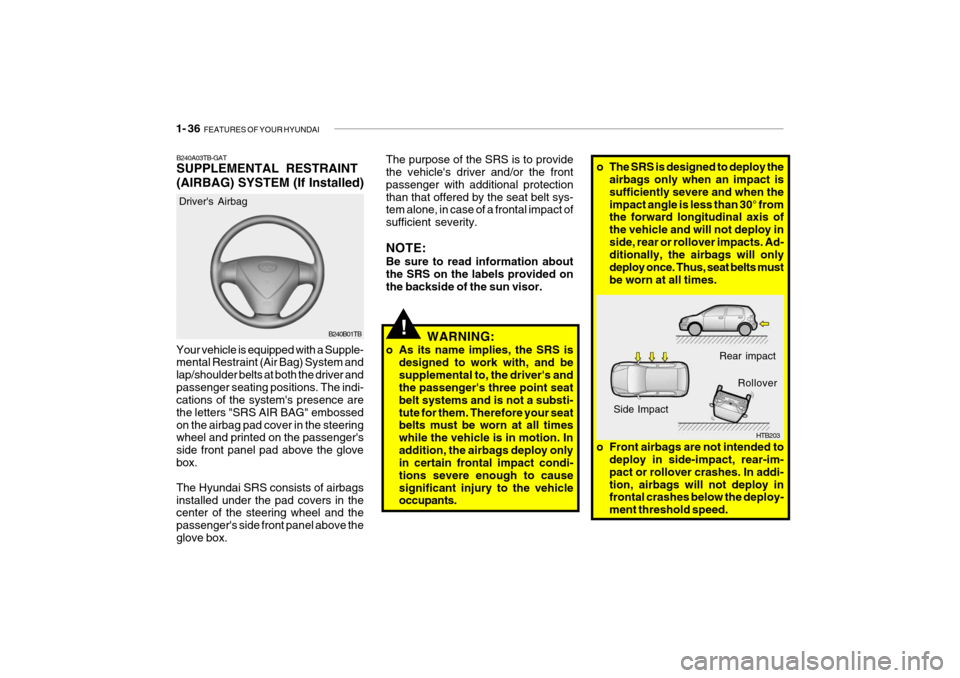
1- 36 FEATURES OF YOUR HYUNDAI
HTB203
Rear impact
Side Impact Rollover
o Front airbags are not intended to deploy in side-impact, rear-im- pact or rollover crashes. In addi-tion, airbags will not deploy in frontal crashes below the deploy- ment threshold speed.
o The SRS is designed to deploy the
airbags only when an impact issufficiently severe and when theimpact angle is less than 30° from the forward longitudinal axis of the vehicle and will not deploy inside, rear or rollover impacts. Ad- ditionally, the airbags will only deploy once. Thus, seat belts mustbe worn at all times.
B240B01TB
Driver's Airbag
Your vehicle is equipped with a Supple- mental Restraint (Air Bag) System and lap/shoulder belts at both the driver andpassenger seating positions. The indi- cations of the system's presence are the letters "SRS AIR BAG" embossedon the airbag pad cover in the steering wheel and printed on the passenger's side front panel pad above the glovebox. The Hyundai SRS consists of airbags installed under the pad covers in the center of the steering wheel and the passenger's side front panel above theglove box. B240A03TB-GAT SUPPLEMENTAL RESTRAINT (AIRBAG) SYSTEM (If Installed)
The purpose of the SRS is to provide the vehicle's driver and/or the front passenger with additional protectionthan that offered by the seat belt sys- tem alone, in case of a frontal impact of sufficient severity. NOTE: Be sure to read information about the SRS on the labels provided onthe backside of the sun visor.
WARNING:
o As its name implies, the SRS is designed to work with, and besupplemental to, the driver's and the passenger's three point seat belt systems and is not a substi-tute for them. Therefore your seat belts must be worn at all times while the vehicle is in motion. Inaddition, the airbags deploy only in certain frontal impact condi- tions severe enough to causesignificant injury to the vehicle occupants.
!
Page 49 of 254
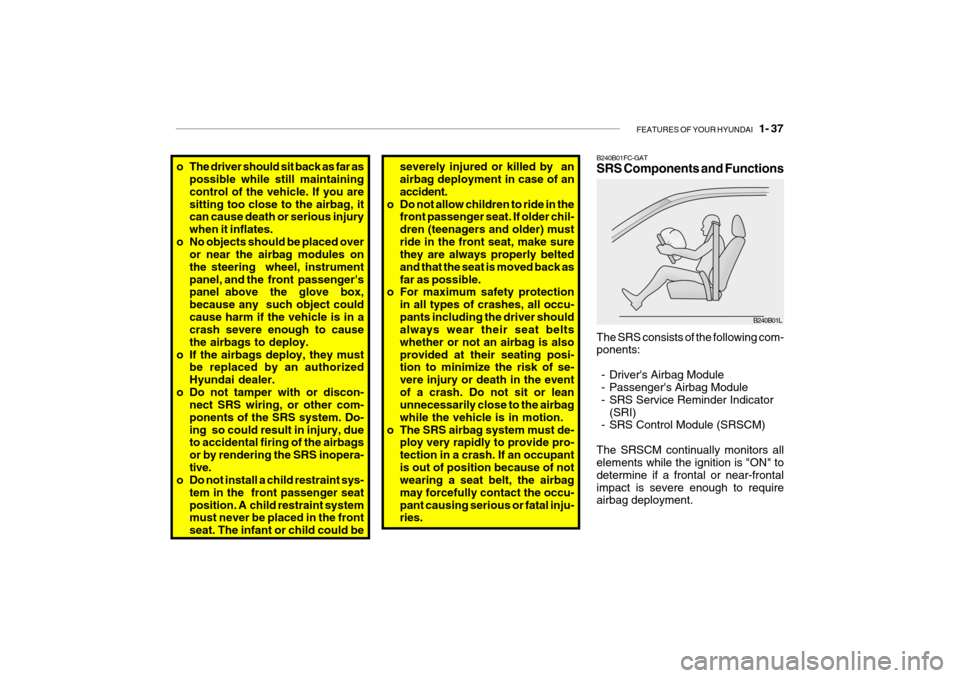
FEATURES OF YOUR HYUNDAI 1- 37
severely injured or killed by an airbag deployment in case of an accident.
o Do not allow children to ride in the front passenger seat. If older chil-dren (teenagers and older) mustride in the front seat, make sure they are always properly belted and that the seat is moved back asfar as possible.
o For maximum safety protection
in all types of crashes, all occu-pants including the driver should always wear their seat belts whether or not an airbag is alsoprovided at their seating posi- tion to minimize the risk of se- vere injury or death in the eventof a crash. Do not sit or lean unnecessarily close to the airbag while the vehicle is in motion.
o The SRS airbag system must de- ploy very rapidly to provide pro-tection in a crash. If an occupantis out of position because of not wearing a seat belt, the airbag may forcefully contact the occu-pant causing serious or fatal inju- ries.o The driver should sit back as far as
possible while still maintaining control of the vehicle. If you aresitting too close to the airbag, it can cause death or serious injury when it inflates.
o No objects should be placed over or near the airbag modules onthe steering wheel, instrumentpanel, and the front passenger's panel above the glove box, because any such object couldcause harm if the vehicle is in a crash severe enough to cause the airbags to deploy.
o If the airbags deploy, they must be replaced by an authorizedHyundai dealer.
o Do not tamper with or discon- nect SRS wiring, or other com-ponents of the SRS system. Do-ing so could result in injury, due to accidental firing of the airbags or by rendering the SRS inopera-tive.
o Do not install a child restraint sys-
tem in the front passenger seatposition. A child restraint system must never be placed in the front seat. The infant or child could be The SRS consists of the following com- ponents:
- Driver's Airbag Module
- Passenger's Airbag Module
- SRS Service Reminder Indicator (SRI)
- SRS Control Module (SRSCM)
The SRSCM continually monitors all elements while the ignition is "ON" to determine if a frontal or near-frontalimpact is severe enough to require airbag deployment.
B240B01FC-GAT SRS Components and Functions
B240B01L
Page 50 of 254
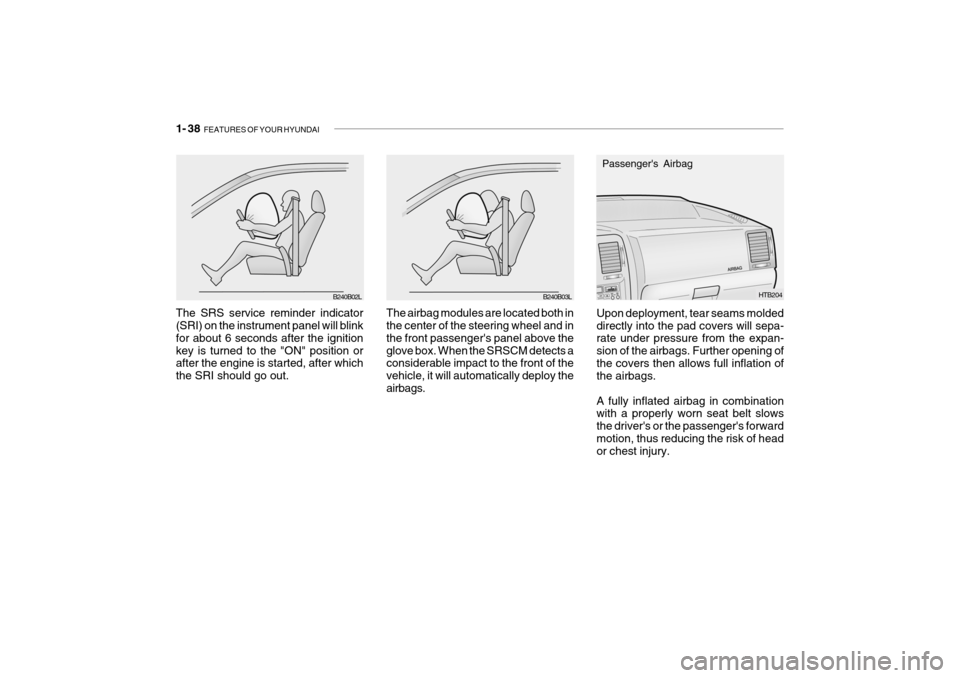
1- 38 FEATURES OF YOUR HYUNDAI
Upon deployment, tear seams molded directly into the pad covers will sepa- rate under pressure from the expan- sion of the airbags. Further opening ofthe covers then allows full inflation of the airbags. A fully inflated airbag in combination with a properly worn seat belt slows the driver's or the passenger's forwardmotion, thus reducing the risk of head or chest injury. HTB204
Passenger's Airbag
B240B02L
The SRS service reminder indicator (SRI) on the instrument panel will blink for about 6 seconds after the ignitionkey is turned to the "ON" position or after the engine is started, after which the SRI should go out. The airbag modules are located both in the center of the steering wheel and in the front passenger's panel above theglove box. When the SRSCM detects a considerable impact to the front of the vehicle, it will automatically deploy theairbags.B240B03L
Page 52 of 254
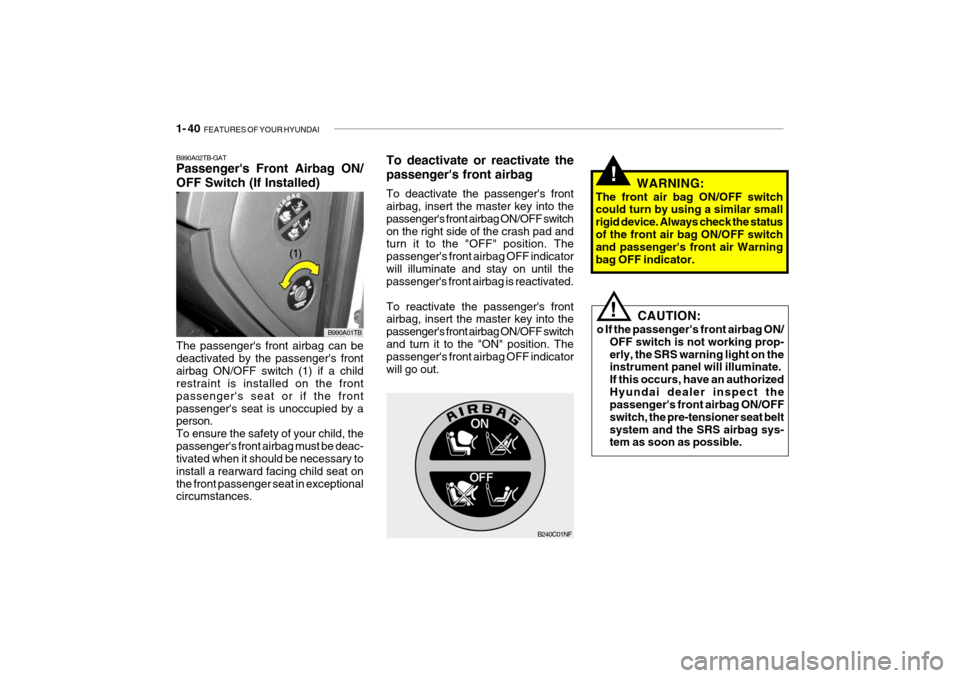
1- 40 FEATURES OF YOUR HYUNDAI
!
CAUTION:
o If the passenger's front airbag ON/ OFF switch is not working prop- erly, the SRS warning light on the instrument panel will illuminate. If this occurs, have an authorizedHyundai dealer inspect the passenger's front airbag ON/OFF switch, the pre-tensioner seat beltsystem and the SRS airbag sys- tem as soon as possible.
B240C01NF
B990A02TB-GAT Passenger's Front Airbag ON/ OFF Switch (If Installed)
B990A01TB
The passenger's front airbag can be deactivated by the passenger's frontairbag ON/OFF switch (1) if a child restraint is installed on the front passenger's seat or if the frontpassenger's seat is unoccupied by a person. To ensure the safety of your child, thepassenger's front airbag must be deac- tivated when it should be necessary to install a rearward facing child seat onthe front passenger seat in exceptional circumstances. (1)
To deactivate or reactivate the passenger's front airbag To deactivate the passenger's front airbag, insert the master key into the passenger's front airbag ON/OFF switchon the right side of the crash pad and
turn it to the "OFF" position. The passenger's front airbag OFF indicatorwill illuminate and stay on until the passenger's front airbag is reactivated. To reactivate the passenger's front airbag, insert the master key into the passenger's front airbag ON/OFF switchand turn it to the "ON" position. The passenger's front airbag OFF indicator will go out.
!WARNING:
The front air bag ON/OFF switch could turn by using a similar small rigid device. Always check the statusof the front air bag ON/OFF switch and passenger's front air Warning bag OFF indicator.
Page 53 of 254
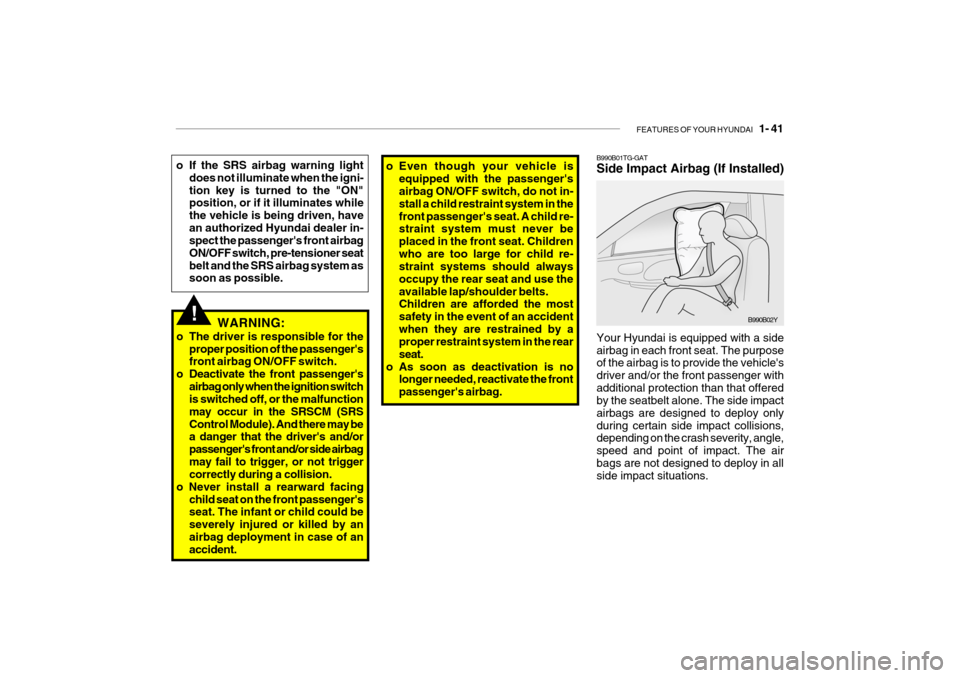
FEATURES OF YOUR HYUNDAI 1- 41
!WARNING:
o The driver is responsible for the proper position of the passenger's front airbag ON/OFF switch.
o Deactivate the front passenger's airbag only when the ignition switchis switched off, or the malfunction may occur in the SRSCM (SRSControl Module). And there may be a danger that the driver's and/or passenger's front and/or side airbagmay fail to trigger, or not trigger correctly during a collision.
o Never install a rearward facing child seat on the front passenger'sseat. The infant or child could be severely injured or killed by anairbag deployment in case of an accident.
o Even though your vehicle isequipped with the passenger's airbag ON/OFF switch, do not in- stall a child restraint system in thefront passenger's seat. A child re- straint system must never be placed in the front seat. Childrenwho are too large for child re- straint systems should always occupy the rear seat and use theavailable lap/shoulder belts. Children are afforded the most safety in the event of an accidentwhen they are restrained by a proper restraint system in the rear seat.
o As soon as deactivation is no longer needed, reactivate the frontpassenger's airbag. B990B01TG-GAT Side Impact Airbag (If Installed) Your Hyundai is equipped with a side airbag in each front seat. The purpose of the airbag is to provide the vehicle's driver and/or the front passenger withadditional protection than that offered by the seatbelt alone. The side impact airbags are designed to deploy onlyduring certain side impact collisions, depending on the crash severity, angle, speed and point of impact. The airbags are not designed to deploy in all side impact situations.
B990B02Y
o If the SRS airbag warning light
does not illuminate when the igni- tion key is turned to the "ON" position, or if it illuminates while the vehicle is being driven, havean authorized Hyundai dealer in- spect the passenger's front airbag ON/OFF switch, pre-tensioner seatbelt and the SRS airbag system as soon as possible.
Page 54 of 254
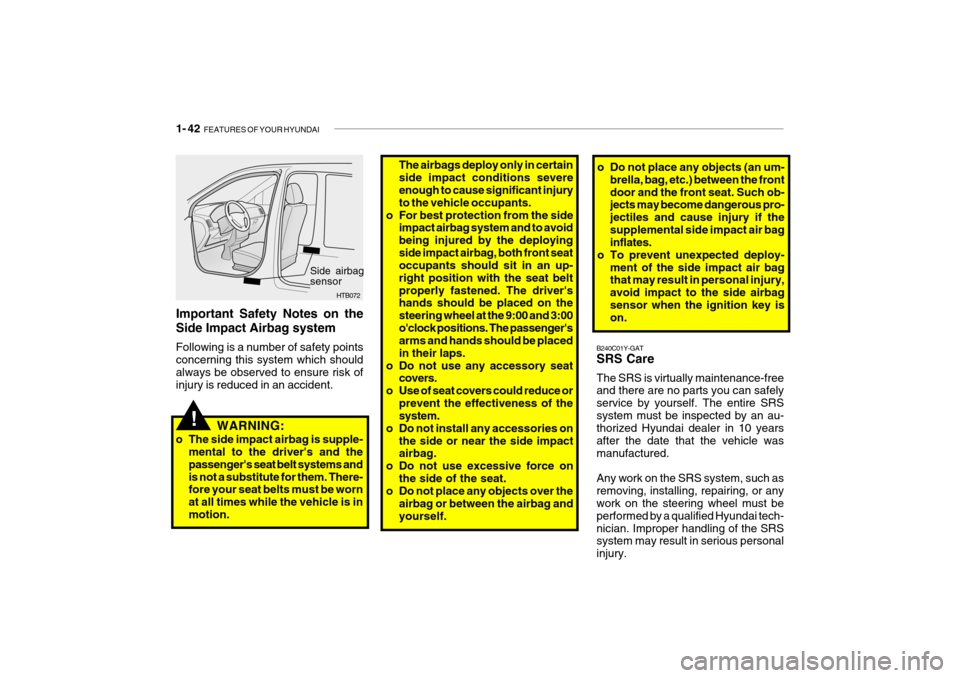
1- 42 FEATURES OF YOUR HYUNDAI
B240C01Y-GAT SRS Care The SRS is virtually maintenance-free and there are no parts you can safely service by yourself. The entire SRSsystem must be inspected by an au- thorized Hyundai dealer in 10 years after the date that the vehicle wasmanufactured. Any work on the SRS system, such as removing, installing, repairing, or any work on the steering wheel must be performed by a qualified Hyundai tech-nician. Improper handling of the SRS system may result in serious personal injury.
The airbags deploy only in certain side impact conditions severe enough to cause significant injury to the vehicle occupants.
o For best protection from the side impact airbag system and to avoidbeing injured by the deployingside impact airbag, both front seat occupants should sit in an up- right position with the seat beltproperly fastened. The driver's hands should be placed on the steering wheel at the 9:00 and 3:00o'clock positions. The passenger's arms and hands should be placed in their laps.
o Do not use any accessory seat covers.
o Use of seat covers could reduce or
prevent the effectiveness of the system.
o Do not install any accessories on
the side or near the side impactairbag.
o Do not use excessive force on
the side of the seat.
o Do not place any objects over the
airbag or between the airbag and yourself. o Do not place any objects (an um-
brella, bag, etc.) between the frontdoor and the front seat. Such ob- jects may become dangerous pro- jectiles and cause injury if thesupplemental side impact air bag inflates.
o To prevent unexpected deploy- ment of the side impact air bagthat may result in personal injury, avoid impact to the side airbagsensor when the ignition key is on.
HTB072
Side airbag sensor
!WARNING:
o The side impact airbag is supple- mental to the driver's and the passenger's seat belt systems andis not a substitute for them. There- fore your seat belts must be worn at all times while the vehicle is inmotion.
Important Safety Notes on the Side Impact Airbag system Following is a number of safety points concerning this system which should always be observed to ensure risk ofinjury is reduced in an accident.
Page 57 of 254

FEATURES OF YOUR HYUNDAI 1- 45
1. Tail Gate Open Warning Light
2. Immobilizer Warning Indicator Light (If installed)
3. Tachometer
4. Turn Signal Indicator Light
5. Automatic Transaxle Position Indicator Light
(If installed)
6. Fuel Gauge
7. Odometer/Trip Odometer
8. Speedometer
9. Electric Power Steering Warning Light (If installed)
10. Malfunction Indicator Light (MIL) (If installed)
11. Diesel Pre-heat Indicator Light (Diesel only)
12. High Beam Indicator Light
13. Engine Coolant Temperature Indicator Light
14. Parking Brake/Brake Fluid Level Warning Light 15. Door Ajar Warning Light
16. Passenger's Front Airbag OFF Indicator Light
(If installed)
17. SRS (Airbag) Warning Light
(If installed)
18. Low Fuel Warning Light
19. Electronic Stability Program (ESP) Indicator Light (If installed)
20. ABS Warning Light (If installed)
21. Fuel Filter Warning Light (Diesel only)
22. Seat Belt Warning Light
23. Oil Pressure Warning Light
24. Charging System Warning Light
25. Overdrive off Indicator Light (Auto T/A only)
Page 59 of 254

FEATURES OF YOUR HYUNDAI 1- 47
1. Tail Gate Open Warning Light
2. Immobilizer Warning Indicator Light (If installed)
3. Tachometer
4. Turn Signal Indicator Light
5. Automatic Transaxle Position Indicator Light
(If installed)
6. Odometer/Trip Odometer
7. Fuel Gauge
8. Trip Computer (If installed)
9. Speedometer
10. Electric Power Steering Warning Light (If installed)
11. Malfunction Indicator Light (MIL) (If installed)
12. Diesel Pre-heat Indicator Light (Diesel only)
13. High Beam Indicator Light
14. Engine Coolant Temperature Indicator Light 15. Parking Brake/Brake Fluid Level Warning Light
16. Door Ajar Warning Light
17. Passenger's Front Airbag OFF Indicator Light
(If installed)
18. SRS (Airbag) Warning Light (If installed)
19. Low Fuel Warning Light
20. Electronic Stability Program (ESP) Indicator Light (If installed)
21. ABS Warning Light (If installed)
22. Fuel Filter Warning Light (Diesel only)
23. Seat Belt Warning Light
24. Oil Pressure Warning Light
25. Charging System Warning Light
26. Overdrive Off Indcator Light (Auto T/A only)
Page 63 of 254

FEATURES OF YOUR HYUNDAI 1- 51
B260J01S-GAT
Charging System Warning Light
The charging system warning light should come on when the ignition isturned on, then go out when the engine is running. If the light stays on while the engine is running, there is a malfunc-tion in the electrical charging system. If the light comes on while you are driv- ing, stop, turn off the engine and checkunder the hood. First, make certain the generator drive belt is in place. If it is, check the tension of the belt.And then, have the system checked by your Hyundai dealer. B260L01A-GAT
Door Ajar Warning Light
The door ajar warning light warns youthat a door is not completely closed.
B260K01B-GAT
Tail Gate Open Warning Light
This light remains on unless the tail gate is completely closed. B260M01A-AAT Low Fuel Level Warning Light
The low fuel level warning light comes on when the fuel tank is approaching empty. When it comes on, you shouldadd fuel as soon as possible. Driving with the fuel level warning light on or with the fuel level below "E" can causethe engine to misfire and damage the catalytic converter.
CAUTION:
If the drive belt (generator belt) is loosen, broken, or mission while thevehicle is driving, there may be a serious malfunction, engine could overheat because this belt alsodrives the water pump.!
B260N02FC-GAT Malfunction Indicator Light (If installed)
This light illuminates when there is a malfunction of an exhaust gas related component, and the system is not
functioning properly so that the exhaust gas regulation values are not satisfied. This light will illuminate when the igni-tion key is tuned to the "ON" position, and will go out after the engine start. If it illuminates while driving, or does notilluminate when the ignition key is turned to the "ON" position, take your car to your nearest authorized Hyundai dealerand have the system checked.
B260E01TB-GAT Seat Belt Warning Light
(Except E.C)
The seat belt warning light blinks for about 6 seconds when the ignition keyis turned from the "OFF" position to the "ON".
Page 64 of 254

1- 52 FEATURES OF YOUR HYUNDAI
CAUTION:
When you move the electric power steering back-end and forth-end continuously in stop position, steer- ing wheel plays heavily to operateanti-overload system. It is normal condition. It returns to be normal getting time.!
B260T01TB-GAT
Electric Power SteeringSystem (EPS)Warning Light(If installed)
This indicator light comes on about 4 seconds after the ignition key is turned to the "ON" position or after the engine is started, it will go out.This light also comes on when the EPS has some troubles. If it comes on while driving, have your vehicle inspected byan authorized Hyundai Dealer.
*1) When the ignition key is turned from "OFF" position to "ON" within 1 minute.
*2) If the vehicle speed exceeds 9km/ h, the seat belt chime also soundsfor about 1~2 minutes. If the vehicle speed is below 9km/h,1 minute later the seat belt chime also sounds for about 1~2 minutes.
The seat belt warning light and chimewill activate to the following table.
B265E01TB-GAT
Seat Belt Warning Light
and Chime (E.C only)
User (Driver) Condition
Seat Belt WarningLight
Seat Belt Ignition Switch
Unbuckled ON Stay on until buckled up
Buckled ON Come on for 6 seconds
Unbuckled ON * 1
Blink until buckled up
ON Blink until buckled up* 2
Buckled
��
��
�
Unbuckled NOTE: If the driver's seat belt is operated in this order "unbuckled
��
��
� buckled
��
��
�
unbuckled ��
��
� buckled
� �
� �
� unbuck-
led" within 9 seconds after the seatbelt is buckled, the seat belt warning light and chime will not activate.